
Nina Garcia is having a moment. We're standing on top of the Mendenhall Glacier just outside of Juneau, Alaska, and although she, in theory, would like to say something, speech is not happening right now. Instead, Marie Claire's Creative Director stares silently at the vast, glittering, 3,000-year-old ice field in front of us. "My God," she says finally, softly. "Oh, my God."
It does that to you, Alaska. Knocks the words right out of your head. Leaves you speechless as you pass fields full of bald eagles the size of apes alongside Lemon Creek and the massive turquoise ice sculptures that float like cruise ships in Holkham Bay.
"Hear that?" says Earthjustice's vice president of litigation for climate and energy, Abigail Dillen—our on-ground expert in this otherworldly place. A 44-year-old sprite with a cap of curly bronze hair, Dillen typically spends her days working in the courts and Congress to secure enforceable cuts in climate pollution and create pathways for clean power through litigation that challenges our reliance on fossil fuels. She cocks her head in the direction of the quiet but steady sound of water dripping off to our left.
The fashion business is responsible for 85 percent of all textiles that end up in landfills—about 21 billion tons—and for 10 percent of global carbon emissions.
"What is it?" asks Garcia. "That's the sound of the glacier," says Dillen, "melting." We've come to Alaska with Earthjustice—the nation's top nonprofit public interest environmental law firm—for a crash course in climate change. We're also here to look at some of the extraordinary efforts now being made within the fashion industry—both to curb its role in climate change (which is significant) and to transform the business in a way that no one could have imagined 30 years ago.
Chief among the game changers is the unlikely duo of Nobel Peace Prize winner Muhammad Yunus and former high-fashion power boss Cara Smyth. Together, Yunus and Smyth are the founding force behind Glasgow Caledonian University's (GCU) Fair Fashion Center, a non-profit based in New York, where many of fashion's biggest players come to reinvent their companies within the context of our rapidly warming planet. Along the way, they're answering a question posed by Yunus that's quietly revolutionizing the industry: "Can fashion be an instrument of sustainable development? And, if so, how?"

Smyth and Yunus first met back in 2014. Smyth had had a long, successful career in luxury fashion, including stints as president of Jil Sander America, a director of Burberry Prorsum, and CEO of Italian fashion brand Menichetti International. Yunus had won the Nobel in 2006 for pioneering microfinance (which helps people in developing countries start their own businesses by giving them loans) and was also the chancellor of GCU. It was in this role that Yunus asked Smyth his question.
"At first, I didn't really know if such a thing was possible," recalls Smyth, a striking woman in her late 40s with a mane of strawberry-blonde hair, mint-green eyes, and a Long Island accent studded with Italian and German from years spent living abroad. "I grew up in the business at a time when nobody was talking about sustainability, other than maybe Patagonia. I don't think any of us realized the impact the business had on people and on the climate."
Stay In The Know
Marie Claire email subscribers get intel on fashion and beauty trends, hot-off-the-press celebrity news, and more. Sign up here.
The fashion business, which brings in $2.5 trillion per year, is responsible for 85 percent of all textiles that end up in landfills (about 21 billion tons) each year and for 10 percent of global carbon emissions, which are the primary source of human-caused global warming. The fashion industry is also the second-largest user of water, research by the Danish Fashion Institute shows, currently contributing 20 percent of the industrial water waste on the planet.
"The numbers terrified me," says Smyth, who started asking industry friends questions most didn't feel like answering. "It was a lot of, 'Cara, leave me out of this. Talk to somebody else.'" She remembers laughing with a friend about the absurdity of what she was trying to do: "He said, 'Do you really think you can rebrand sustainability? Everybody thinks it's sad, brown trousers and granola and poor lady in Bangladesh.'"
Still, alliances like the Sustainable Apparel Coalition (SAC)—a nonprofit founded by Patagonia and Walmart in 2009—seemed to indicate a growing desire for sustainability. (Today, the SAC boasts more than 180 members, including H&M and Nike.) She thought, There has to be a way.
Back on the Mendenhall Glacier, Dillen is explaining how global warming works. "Basically, whenever fossil fuels—such as oil and gas— are burned, carbon dioxide and other greenhouse gases are released. These gases then trap heat from the sun inside the Earth's atmosphere," she says. "Think of a blanket around the planet that keeps getting thicker just when we need to start cooling down."
The general consensus is that the planet's temperature must not be allowed to rise more than 2 degrees Celsius above pre-Industrial levels. Last December's Paris Agreement—in which 195 countries adopted a landmark climate pact to limit global warming—set 2 degrees Celsius as the maximum heat increase the planet can handle, while noting that 1.5 degrees is a far more desirable target from the perspective of human welfare. At 2 degrees, says Dillen, postcards from the future will include super droughts ("like, California droughts"), more Zika-type viruses, mass animal extinction, floods of refugees, and the loss of most of our glaciers and sea ice. "We need to do everything we can to keep warming below 1.5 degrees."
"What happens if we don't?" Garcia asks, looking down at tear-shaped pools filled with impossibly clear turquoise water known as "meltwater." "What happens if the glaciers do melt?"
Dillen's eyes widen; then she responds, "If all the glaciers melt, we flood every coastal city on the planet." Sea levels have risen eight inches on average globally over the past 100 years, and most scientists predict that they will rise another two to six feet in our century (with highly respected scientists—like James Hansen, director of the Program on Climate Science, Awareness and Solutions at Columbia University's Earth Institute—predicting that sea levels could rise as much as six to 15 feet). "We're talking about New York City, Mumbai, and Shanghai under water," Dillen continues. "The scale of the dislocation is hard to even imagine."
In Alaska, the results of ice loss and rising seas are already all too present. Spend a night talking to people in Juneau, and you'll hear stories of starving polar bears up in the Northwest Territories and native villages crashing into the Beaufort Sea. You'll hear that it's hardly snowed in Juneau for two years and that 80 sea otters washed up onshore dead the other day from eating toxic algae—poisoned by an overheated sea. "You don't want people to be depressed, because then they become paralyzed," says John Neary, director of the Mendenhall Glacier Visitor Center, "but it's important for all of us to look at what our current lifestyles are costing us and to realize that we can do things differently."
Sitaantaagu was the Mendenhall Glacier's original name. That's what the Tlingit people—and everyone else—called it. (In 1891, white folks renamed it after a meteorologist from Ohio.) It means "the glacier behind the town," which is a pretty apt name for the pale-blue beast of ice that spreads behind Juneau like a spilled milk shake—13 miles long and hundreds of feet thick. It lures about 750,000 visitors per year to this remote archipelago in southeast Alaska (most via cruise ships). And it's the thing everyone in Juneau talks about more or less all the time: how awesome it is, how totally screwed it is.
If all the glaciers melt, we flood every coastal city on the planet. We're talking about New York City, Mumbai, and Shanghai under water.
Exactly how screwed is a matter of debate. Certainly, the fact that it has receded 2.5 miles over the past 250 years (and 1.5 miles in the past century alone) is not good. Nor that Alaska's glaciers in general are losing 75 gigatons—aka 75 billion tons—of ice each year. But even dire climate experts say that if the world would commit to cutting emissions by about 6 percent a year, the climate could be stabilized. "There's a very small window where we still have a choice about what the future looks like," says Dillen. "But it's closing very quickly."
There are a lot of ways to see Sitaantaagu up close. You can hike up to it, helicopter over it, kayak across Mendenhall Lake toward it, or just gaze at it from behind the window at the visitor center. But I'd argue that the most breathtaking way to see the glacier is from underneath, inside the ice caves.
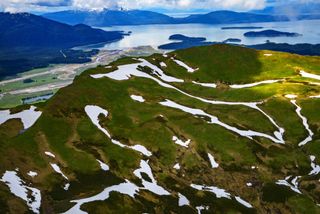
Melting glaciers raise sea levels and, as a result, risks of flooding, jeopardizing coastal towns around the world.
Stepping into the Mendenhall Glacier's ice caves is like entering another dimension. For starters, they're blue—a wild, bright Windex blue—and clear as glass, very, very thick glass, only the glass is all sculpted and hugely bubbled within, so walking through them feels like walking through a dreamscape in some crazy Stanley Kubrick movie or a really huge sapphire. You're surrounded by this glowing blue city of ice, ice with prehistoric trees frozen inside, ice that was here when the mammoths walked.
"Hey, Nina, whaddya think: Fashion Week or the glacier?" asks our photographer, National Geographic's Pete McBride, when we climb out at last, blinking and gasping in the sunlight.
"Are you kidding me?" she responds. "The glacier. It's not even a question."
Our captain is explaining the process of glacier "calving," or chunks breaking off due to warm weather, when he suddenly yells, "Hang on!" and starts backing up the boat. "Oh, yeah! She's gonna go!
Later, Garcia and I start talking about how excited we are to bring our families back here. "You better hurry," says our guide, Elliot Sofhauser. "Caves are gonna be gone within a year or two. They say this summer is probably the last one. After that, the lip over the entrance will melt, and the whole thing will just collapse."
It's hard to imagine a more dramatic illustration of climate change in Alaska than the glacier's ice caves collapsing—until another example arrives, as if on schedule, the next morning. We've taken a boat three hours south of Juneau into a remote wilderness area called the Tracy Arm fjord to see a dramatic piece of ice known as the Sawyer Glacier. Icebergs ranging from XS to XXL dot the bay, along with dozens of harbor seals lolling belly-up in the sun as two black bears and a brown one lumber along the rocky shoreline. At the pale, milky blue feet of the massive glacier, our captain, Steve Weber, is explaining the process of glacier "calving," or chunks breaking off, increasingly common with all the warm weather, when he suddenly yells, "Hang on!" and starts backing up the boat fast. "Oh, yeah! She's gonna go!"

Located in the Tracy Arm fjord outside Juneau, the Sawyer Glacier calves an iceberg (when a chunk of ice breaks from a glacier as a result of warmer waters)
And then it happens. A long skinny crack that runs partway along the glacier's face shoots suddenly down the rest of it. A sound like two planets crashing into each other thunders from inside, and a slice of glacier the size of a house breaks off and slides into the sea.
A little while later, we're sitting in the main cabin of the Adventure Bound, quietly mulling what we just witnessed. "It's hard to think about," Garcia says. "That our actions are responsible for this."
"I think a lot of people feel like it's too depressing to even look at," says Dillen. "Like, I don't know what to do; I am complicit in this disaster."
"I understand that," says Garcia. "I think a lot of people feel that way. Like, What can I do?"
But we actually can do something about it," Dillen says. "We have the technology now to power our lives with clean energy
"But we actually can do something about it," Dillen says. "We have the technology now to power our lives with clean energy. In 10 years, we've gone from not having very good answers about how to power this country without coal to being at a place where clean energy is the cheap solution, as well as the one that's good for the planet."
Garcia looks at her. "But changing the infrastructure would be very expensive, no?"

Nina Garcia with a bald eagle
"Not nearly as expensive as it will be to lose all of our coastal cities to flooding," says Dillen. "And think what it would do for our economy to create a new clean-energy sector. It's hard to imagine a more powerful engine to create new jobs and new wealth. Right now, we have an infra- structure in the U.S. that's crumbling, and we're going to end up spend- ing trillions of dollars one way or another to keep the lights on. Why fix up an old energy system that's putting us all in so much danger, when we could invest in a clean new one that will improve everyone's life for the better?" A few moments later, Garcia says, "So a lot of this depends on policy—on who we vote into office in November."
Dillen nods. "There could not be more at stake in November. There's a lot we can do on an individual level—drive less, fly less, eat less meat, spend our money on clothes that last—but the biggest changes have to come at the level of government spending. And I really believe women are the key here. When I lie awake at night, worrying about what kind of world my son is going to inherit, I find myself thinking that if we can just get women to come together on this, to talk about climate—ask the candidates what their energy platforms are, demand that they ramp up clean energy, vote for the people whose policy resonates with them—we can solve it. But we have to do it right now. Everything hinges on what happens in the next five years."
Cara Smyth eventually answered Yunus' question. She would not tell you that it is the solution to all climate-change problems, but she might acknowledge that it's an important step in the right direction. Like a lot of great answers in life, it came to her in the form of yet another question: Can we prove the business case for sustainability in fashion?
In 2014, Smyth and Yunus founded GCU's Fair Fashion Center in hopes of answering this question. Headquartered inside a white-and-glass aerie in Soho, it's a place pretty much nobody knows about outside of fashion's biggest insiders. The center describes its mission this way: to "aggregate exist- ing industry best practices, source new opportunities for engagement, and research emergent tactics and technologies in supply chain sus- tainability and environmental impact reduction."
In other words, it's where CEOs from some of the fashion world's largest companies figure out how to improve sustainable practices while remaining profitable.
At first, getting CEOs to show up was a hell of a project. But eventually, a solution arrived in the form of a very fancy men's dress shirt. One day, while she was shopping, Smyth opened up a tuxedo shirt and realized that each one involved 14 to 18 pieces of packaging, from the little plastic clips to the cardboard collar. "18!" says Smyth. "And it turns out that the pieces typically come from four to six different countries. It just doesn't make sense."

At 1,500 square miles, the Juneau Icefield, which comprises about 140 glaciers (including the Mendenhall Glacier), could disappear by the end of the next century if current warming trends continue
She went to visit a few people in the business and said, "This costs about a dollar and change by the time you fly all the bits around the world—if we could reduce that sum by just 10 percent—remembering that you're selling about 30 million shirts a year—then all of a sudden, you've got profitability and sustainability."
Fashion CEOs understood this immediately. In fact, the dress shirt turned out to be such a perfect example of packaging absurdity and financial opportunity that Smyth started carrying one around in her bag as a visual aid in her presentations. This—along with the statistics of the damage the fashion industry is doing to the environment—persuaded CEOs to come on board.
Women are the key here. If we can just get them to come together to talk about climate, we can solve it.
Currently, the Fair Fashion Center works with 30 CEOs and 211 brands (we're talking luxury conglomerates and major retail and distribution companies) that are together responsible for $200 billion in business. I wish I could tell you who they are, but so far, the big fashion brands prefer that their work remain private, except one: François-Henri Pinault, chairman and CEO of Kering, whose brands include Saint Laurent, Gucci, and Balenciaga. "There is an increased focus on companies being accountable for the environmental and social impacts associated with their business activities and their responsibility to contribute to mitigating climate change," Pinault says. "Kering embraces this responsibility to act. It has been our business imperative for several years to become a more sustainable company, but we will only be successful through collaboration with other stakeholders in the industry to improve standards and practices. The Fair Fashion Center is part of these key partners we're working with, being a unique model that provides the fashion industry with accessible resources that support profitable sustainability through research and a sharing of best practices."
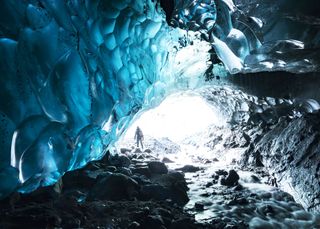
Sofhauser exits the ice caves
Among Fair Fashion's key initiatives and goals are facilitating a 100 percent renewable energy strategy, reducing packaging, and creating an online carbon offset option called NOCO2 (meaning No Carbon Dioxide), which allows customers to round their purchases up to the nearest dollar, with the extra money helping offset the climate impact of whatever they've just bought—along with the attendant shipping. Similarly, when buying clothes online, you'll soon be able to click a button that says "Please Reduce My Packaging" to avoid waste. A pet project of Smyth's is an attempt to turn discarded fabric (that would otherwise end up in landfills) into shipping cartons.
But for all the good she's doing, Smyth has an even bigger dream for sustainable fashion. "Get one of the very top designers to do a sustainable collection for a fashion company that is doing sustainability," she says, "and make that damn thing so cool all day long. So people are like, 'You know what? He's making bags out of post-consumer waste. He's making shoes out of soda bottles.' That would totally change the dialogue. Suddenly, everyone in the world would be into sustainability. I just really feel business can be an incredible force for good, especially fashion."
If you ask her, we shouldn't have to decide between fashion and the glacier. If we start making the right choices, we can have both.
This article appears in the September issue of Marie Claire, on newsstands now.
-
 Caitlin Clark's WNBA Draft Glow Is Courtesy of Glossier
Caitlin Clark's WNBA Draft Glow Is Courtesy of GlossierShe even wore a just-launched product from the brand.
By Julia Marzovilla Published
-
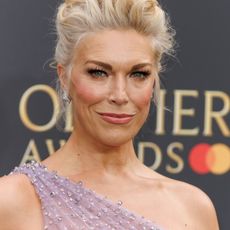 Hannah Waddingham Fiercely Calls Out a Photographer Who Demands She Show More Leg on the Red Carpet
Hannah Waddingham Fiercely Calls Out a Photographer Who Demands She Show More Leg on the Red Carpet“You’d never say that to a man.”
By Rachel Burchfield Published
-
 It Seems Like Everyone’s Obsessed with Rothy’s Shoes
It Seems Like Everyone’s Obsessed with Rothy’s ShoesThis sustainable, one-billion-dollar brand is becoming a go-to for content creators, editors, and A-list celebrities. Here's why.
By Brooke Knappenberger Published
-
 Stylists on Why Leather Jackets Are a Great Investment
Stylists on Why Leather Jackets Are a Great InvestmentFashion insiders weigh in on their favorite styles.
By Lauren Tappan Published
-
 Grown-Ups Are Rediscovering the Charm of Peter Pan Collars
Grown-Ups Are Rediscovering the Charm of Peter Pan CollarsFrom bibbed button-downs to round-neck leather jackets, this year's takes feel more sophisticated than sweet.
By Emma Childs Published
-
 Sabrina Carpenter Wears Vintage Victoria's Secret Lingerie to Tease Upcoming Coachella Performance
Sabrina Carpenter Wears Vintage Victoria's Secret Lingerie to Tease Upcoming Coachella PerformanceHer look was pulled from the brand's 1997 archives.
By Lauren Tappan Published
-
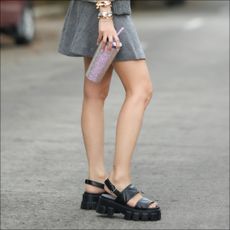 The Best Chunky Sandals Prove Minimalism Is Out
The Best Chunky Sandals Prove Minimalism Is OutAnother footwear trend embracing maximalism in 2024.
By Lauren Tappan Published
-
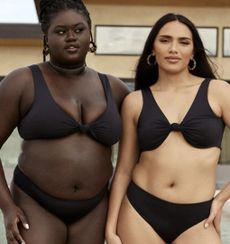 The Brands to Shop for the Best Swimsuits
The Brands to Shop for the Best SwimsuitsFrom size-inclusive labels to sustainable and designer options, this list is all-encompassing.
By Lauren Tappan Published
-
 The Best Vacation-Worthy Beach Dresses
The Best Vacation-Worthy Beach DressesFrom barely-there to playful fringe.
By Lauren Tappan Published
-
 Could a 'Shirt Sandwich' Pull You Out of a Fashion Rut?
Could a 'Shirt Sandwich' Pull You Out of a Fashion Rut?The gourmet styling trick may help you fall back in love with your wardrobe.
By Emma Childs Published
-
 The Best Spring Dresses Simplify Any Outfit Formula
The Best Spring Dresses Simplify Any Outfit FormulaStyle this wardrobe staple for any occasion, from farmer's markets to formal affairs.
By Lauren Tappan Published